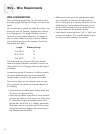
12
Wire – Wire Requirements
WIRE CONSIDERATIONS
When purchasing speaker wire, you will need to select
the proper gauge, determine the length, and choose the
brand.
Wire is measured in gauges: the higher the number, the
thinner the wire. For example, 18-gauge wire is thinner
than 14-gauge wire. The length of speaker wire you’ll
need will vary with speaker placement. The gauge of
wire you need is determined by the distance between
your amplifier/receiver and the speakers. Use the fol-
lowing chart as a guide:
Length Minimum Gauge
10 to 100 ft. 16
80 to 125 ft. 14
Over 100 ft. 12
We recommend using Russound AW series speaker
cable for amplifier-to-speaker connections, but any rep-
utable brand of 16- to 12-gauge multi-stranded wiring is
acceptable.
Incorporating optional IR receivers in Iso-Mount models
will require additional wire. Consult the selected IR
receiver model’s manual for the specific wire needs.
Care must be taken to avoid obstacles when running
wire. In general, you should pay particular attention to
the following:
• Avoid locations concealing pipes, heating ducts, and
AC wiring in the general vicinity.
• Avoid running speaker wires close to house electrical
wiring for any distance. If you have to run them paral-
lel, make sure to space the speaker wires at least
two feet from the AC line. It is, however, permissible
for speaker wires to cross paths with AC line or pass
through the same hole together with house wiring if
they separate before and after.
• Make sure that the entire wire path between speak-
ers and amplifier is clear and not obstructed by a
floor or ceiling joist, or a masonry wall which can’t be
drilled through. Confirm ahead of time that you can
drill an outlet hole easily and in an unobtrusive spot
to connect wires with the amplifier/receiver.
• Label speaker wires at each end “left” or “right” and
include room location. This simplifies speaker/receiv-
er hook-up once the speakers are installed.


















